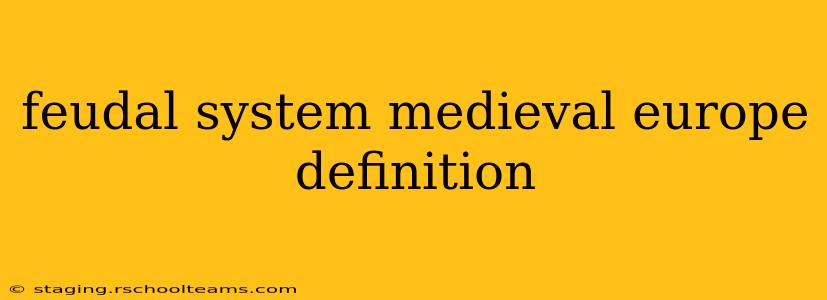The feudal system, a defining characteristic of medieval Europe (roughly 9th to 15th centuries), was a complex socio-political structure based on reciprocal obligations between different social classes. It wasn't a uniform system across the entire continent; variations existed based on geography, culture, and evolving political landscapes. However, certain key elements consistently defined feudalism throughout its existence.
Defining the Core Elements of Feudalism
At the heart of the feudal system lay a hierarchical structure built upon land ownership and personal allegiances. Let's break down the key components:
1. Land Ownership (Fief):
The foundation of feudalism was the fief, a grant of land given by a lord (the grantor) to a vassal (the recipient) in exchange for specific services. These fiefs weren't simply pieces of property; they represented a complex web of rights and responsibilities.
2. Vassalage and Homage:
The relationship between lord and vassal was formalized through a ceremony of homage, where the vassal pledged loyalty and service to the lord. This created a personal bond extending beyond simple economic exchange. Vassals owed their lords military service, advice, and financial contributions (like taxes or aids).
3. Hierarchical Structure:
Feudalism wasn't a simple two-tiered system. The hierarchy was complex, with powerful kings at the apex granting fiefs to powerful nobles (dukes, counts, barons), who in turn granted smaller fiefs to lesser nobles and knights. This created a pyramid-like structure with multiple layers of obligations and allegiances.
4. Obligations and Services:
The reciprocal nature of feudalism meant both lords and vassals had obligations. Vassals provided military service, often obligated to fight for their lord in times of war. They also offered financial support, such as paying taxes or providing resources. Lords, in return, were responsible for protecting their vassals and providing justice within their territories.
5. Decentralized Power:
Unlike centralized systems, feudalism involved a degree of decentralized power. Lords exercised considerable authority within their own fiefs, managing justice, collecting taxes, and organizing local defense. This resulted in a patchwork of relatively independent power centers across the medieval landscape.
Beyond the Basics: Nuances and Variations within the Feudal System
While the core elements described above represent the essence of feudalism, it's crucial to acknowledge the significant variations and complexities:
Regional Differences:
The specifics of feudalism differed considerably across Europe. The system in England, for example, evolved differently than its counterparts in France or the Holy Roman Empire. Local customs and traditions significantly shaped the structure and practice of feudal obligations.
The Role of the Church:
The Catholic Church played a substantial role in medieval society, owning extensive lands and wielding considerable influence. Church officials often held fiefs, participating in the feudal hierarchy while maintaining their religious authority.
The Rise of Towns and the Decline of Feudalism:
The growth of towns and the rise of a merchant class gradually weakened the feudal system. The economic power of towns and the increasing importance of money gradually undermined the land-based economy that underpinned feudalism.
Conclusion: Understanding the Legacy of Feudalism
The feudal system, while complex and multifaceted, profoundly shaped medieval European society. Its influence extended far beyond the mere distribution of land and power; it deeply impacted social structures, political organization, and the development of legal systems. While the feudal system ultimately declined, its legacy continues to inform our understanding of medieval history and the evolution of political and social structures. Understanding its nuances reveals a sophisticated system that far surpasses a simplistic definition.
